Leadership in Business: Theories, Practices, and Impact
VerifiedAdded on 2021/05/31
|11
|2870
|18
Essay
AI Summary
This essay delves into the multifaceted realm of leadership within a business context. It begins by acknowledging the evolving nature of leadership, emphasizing the shift from traditional, control-oriented approaches to more empowering, collaborative, and ethically-driven models. The essay explores various leadership theories, including behavioral and situational approaches, and examines the significance of leader personality traits, values, and attitudes. It then discusses the importance of charismatic and transformational leadership, highlighting the role of mental models, emotional intelligence, and workplace diversity. The essay further addresses strategic communication, moral leadership, and the development of effective teams, including virtual teams. It explores motivation, the dynamics of followership, and the crucial role of strategic leadership in shaping organizational culture and driving change. Overall, the essay underscores the importance of adapting to changing business environments and developing the skills necessary for effective leadership.
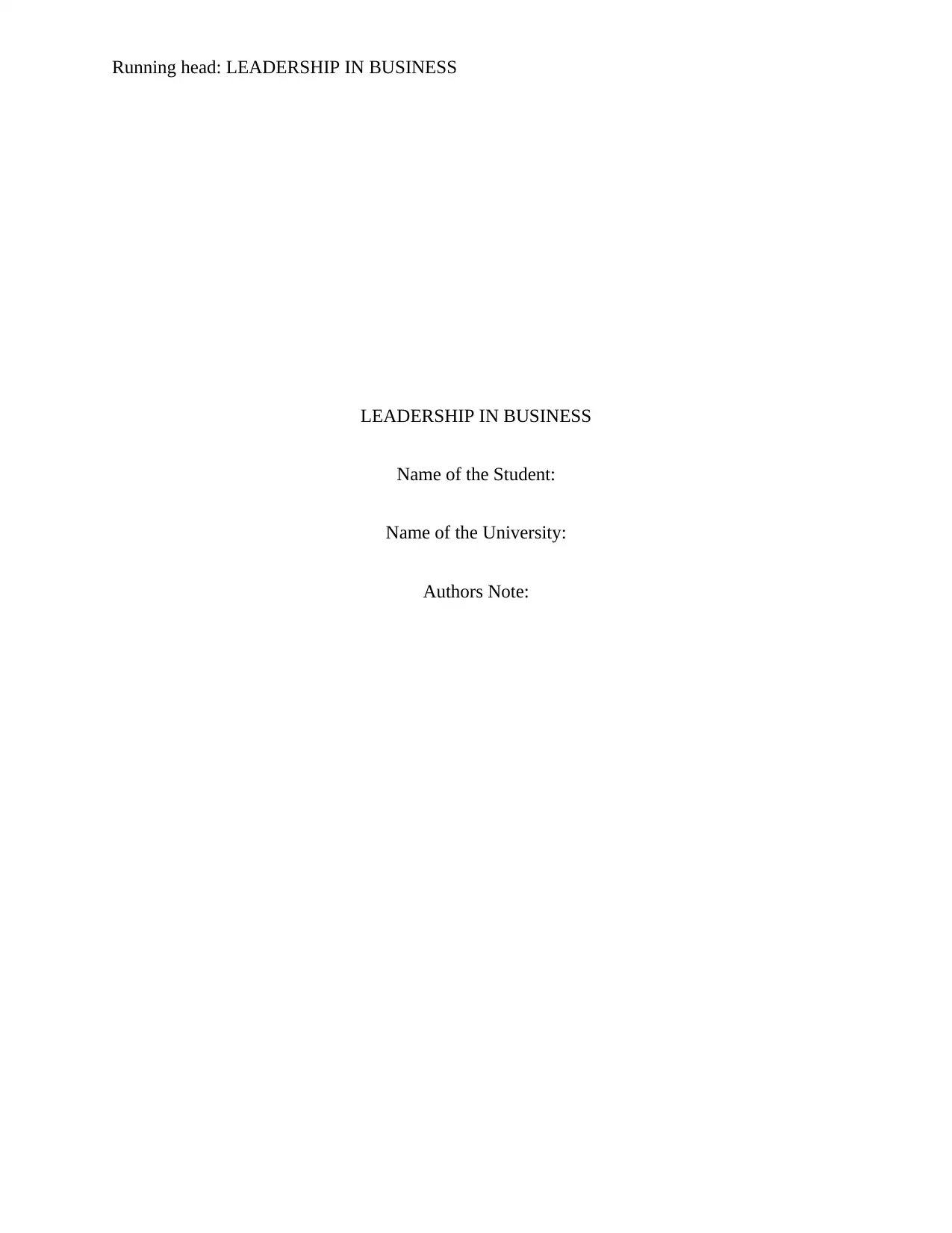
Running head: LEADERSHIP IN BUSINESS
LEADERSHIP IN BUSINESS
Name of the Student:
Name of the University:
Authors Note:
LEADERSHIP IN BUSINESS
Name of the Student:
Name of the University:
Authors Note:
Paraphrase This Document
Need a fresh take? Get an instant paraphrase of this document with our AI Paraphraser
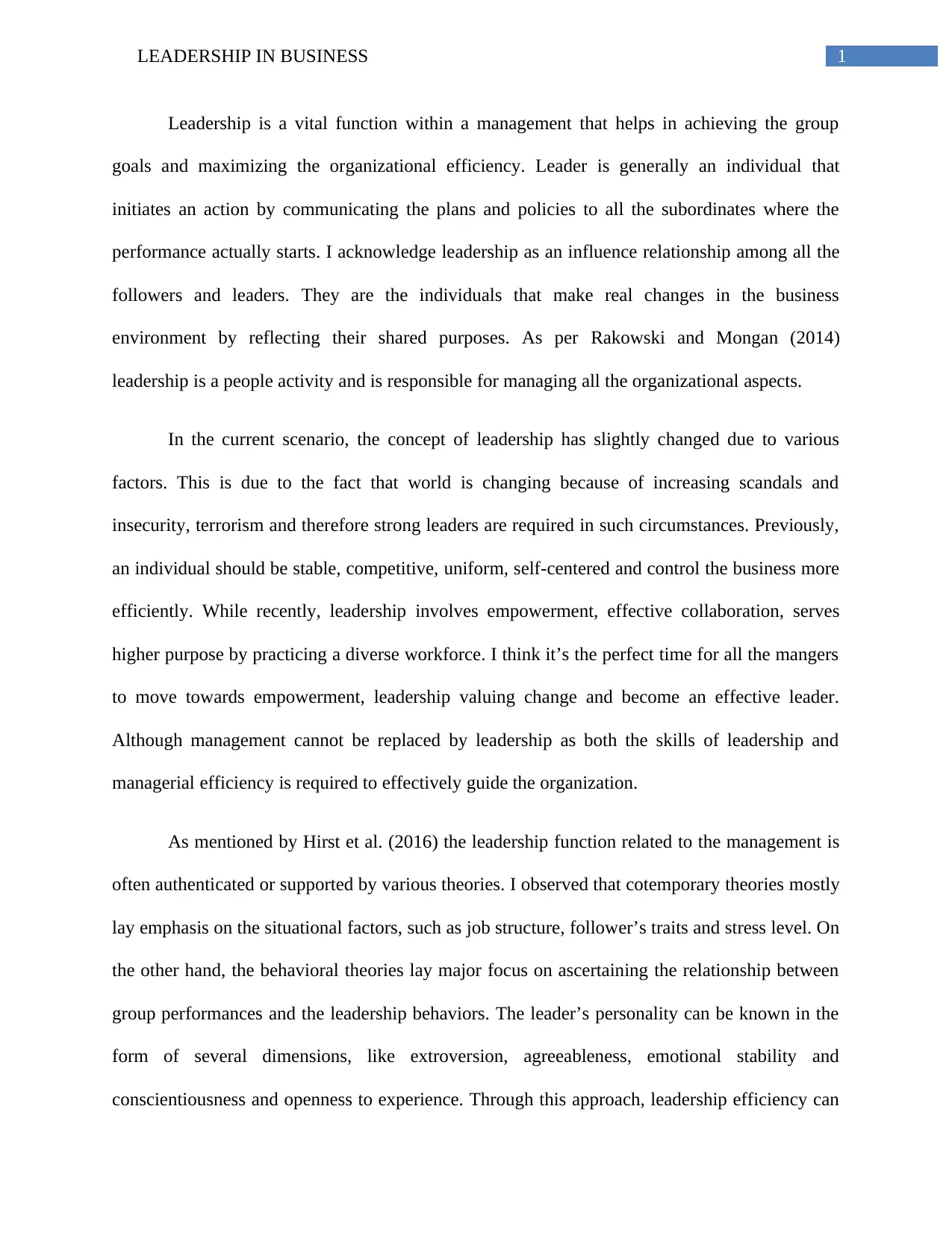
1LEADERSHIP IN BUSINESS
Leadership is a vital function within a management that helps in achieving the group
goals and maximizing the organizational efficiency. Leader is generally an individual that
initiates an action by communicating the plans and policies to all the subordinates where the
performance actually starts. I acknowledge leadership as an influence relationship among all the
followers and leaders. They are the individuals that make real changes in the business
environment by reflecting their shared purposes. As per Rakowski and Mongan (2014)
leadership is a people activity and is responsible for managing all the organizational aspects.
In the current scenario, the concept of leadership has slightly changed due to various
factors. This is due to the fact that world is changing because of increasing scandals and
insecurity, terrorism and therefore strong leaders are required in such circumstances. Previously,
an individual should be stable, competitive, uniform, self-centered and control the business more
efficiently. While recently, leadership involves empowerment, effective collaboration, serves
higher purpose by practicing a diverse workforce. I think it’s the perfect time for all the mangers
to move towards empowerment, leadership valuing change and become an effective leader.
Although management cannot be replaced by leadership as both the skills of leadership and
managerial efficiency is required to effectively guide the organization.
As mentioned by Hirst et al. (2016) the leadership function related to the management is
often authenticated or supported by various theories. I observed that cotemporary theories mostly
lay emphasis on the situational factors, such as job structure, follower’s traits and stress level. On
the other hand, the behavioral theories lay major focus on ascertaining the relationship between
group performances and the leadership behaviors. The leader’s personality can be known in the
form of several dimensions, like extroversion, agreeableness, emotional stability and
conscientiousness and openness to experience. Through this approach, leadership efficiency can
Leadership is a vital function within a management that helps in achieving the group
goals and maximizing the organizational efficiency. Leader is generally an individual that
initiates an action by communicating the plans and policies to all the subordinates where the
performance actually starts. I acknowledge leadership as an influence relationship among all the
followers and leaders. They are the individuals that make real changes in the business
environment by reflecting their shared purposes. As per Rakowski and Mongan (2014)
leadership is a people activity and is responsible for managing all the organizational aspects.
In the current scenario, the concept of leadership has slightly changed due to various
factors. This is due to the fact that world is changing because of increasing scandals and
insecurity, terrorism and therefore strong leaders are required in such circumstances. Previously,
an individual should be stable, competitive, uniform, self-centered and control the business more
efficiently. While recently, leadership involves empowerment, effective collaboration, serves
higher purpose by practicing a diverse workforce. I think it’s the perfect time for all the mangers
to move towards empowerment, leadership valuing change and become an effective leader.
Although management cannot be replaced by leadership as both the skills of leadership and
managerial efficiency is required to effectively guide the organization.
As mentioned by Hirst et al. (2016) the leadership function related to the management is
often authenticated or supported by various theories. I observed that cotemporary theories mostly
lay emphasis on the situational factors, such as job structure, follower’s traits and stress level. On
the other hand, the behavioral theories lay major focus on ascertaining the relationship between
group performances and the leadership behaviors. The leader’s personality can be known in the
form of several dimensions, like extroversion, agreeableness, emotional stability and
conscientiousness and openness to experience. Through this approach, leadership efficiency can
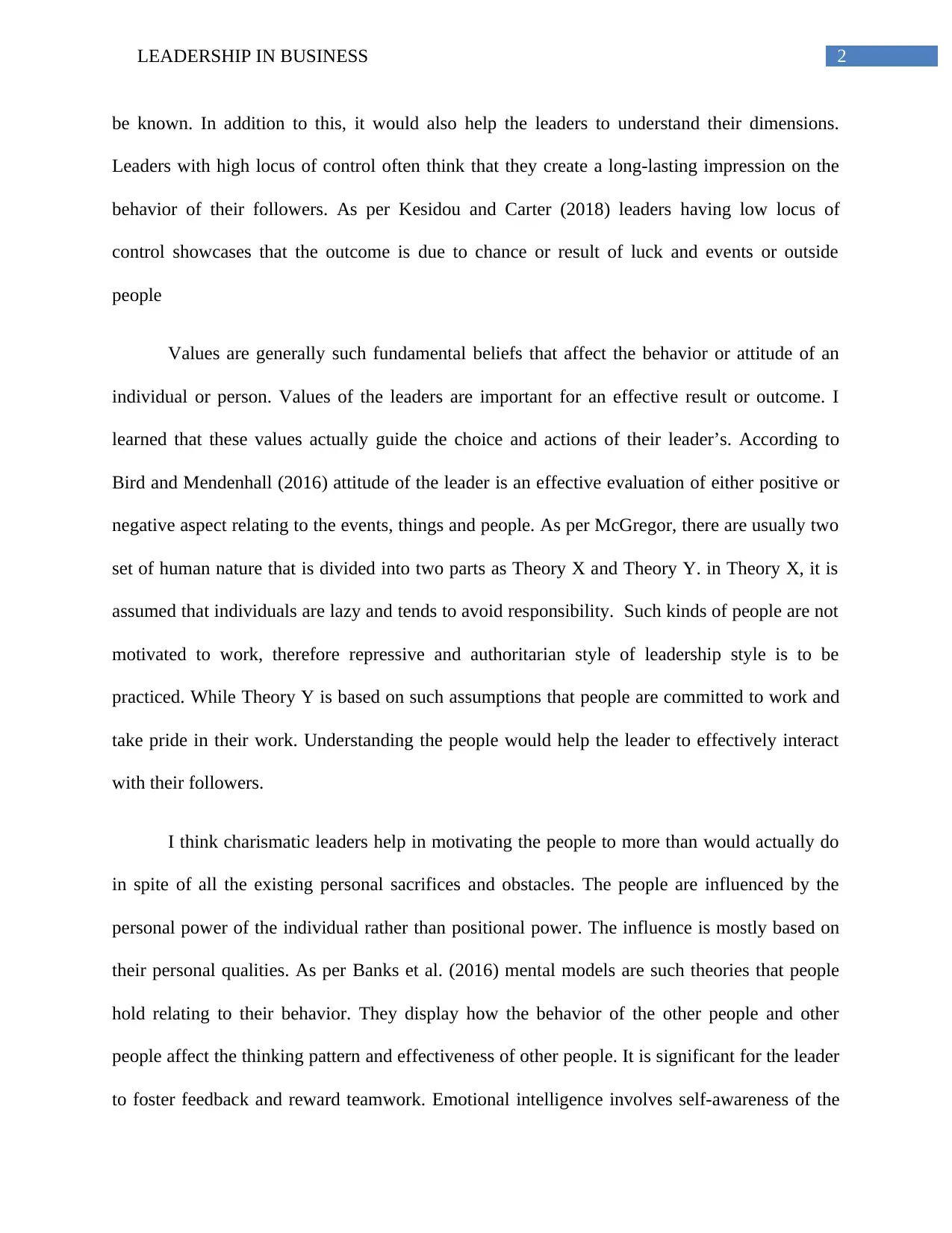
2LEADERSHIP IN BUSINESS
be known. In addition to this, it would also help the leaders to understand their dimensions.
Leaders with high locus of control often think that they create a long-lasting impression on the
behavior of their followers. As per Kesidou and Carter (2018) leaders having low locus of
control showcases that the outcome is due to chance or result of luck and events or outside
people
Values are generally such fundamental beliefs that affect the behavior or attitude of an
individual or person. Values of the leaders are important for an effective result or outcome. I
learned that these values actually guide the choice and actions of their leader’s. According to
Bird and Mendenhall (2016) attitude of the leader is an effective evaluation of either positive or
negative aspect relating to the events, things and people. As per McGregor, there are usually two
set of human nature that is divided into two parts as Theory X and Theory Y. in Theory X, it is
assumed that individuals are lazy and tends to avoid responsibility. Such kinds of people are not
motivated to work, therefore repressive and authoritarian style of leadership style is to be
practiced. While Theory Y is based on such assumptions that people are committed to work and
take pride in their work. Understanding the people would help the leader to effectively interact
with their followers.
I think charismatic leaders help in motivating the people to more than would actually do
in spite of all the existing personal sacrifices and obstacles. The people are influenced by the
personal power of the individual rather than positional power. The influence is mostly based on
their personal qualities. As per Banks et al. (2016) mental models are such theories that people
hold relating to their behavior. They display how the behavior of the other people and other
people affect the thinking pattern and effectiveness of other people. It is significant for the leader
to foster feedback and reward teamwork. Emotional intelligence involves self-awareness of the
be known. In addition to this, it would also help the leaders to understand their dimensions.
Leaders with high locus of control often think that they create a long-lasting impression on the
behavior of their followers. As per Kesidou and Carter (2018) leaders having low locus of
control showcases that the outcome is due to chance or result of luck and events or outside
people
Values are generally such fundamental beliefs that affect the behavior or attitude of an
individual or person. Values of the leaders are important for an effective result or outcome. I
learned that these values actually guide the choice and actions of their leader’s. According to
Bird and Mendenhall (2016) attitude of the leader is an effective evaluation of either positive or
negative aspect relating to the events, things and people. As per McGregor, there are usually two
set of human nature that is divided into two parts as Theory X and Theory Y. in Theory X, it is
assumed that individuals are lazy and tends to avoid responsibility. Such kinds of people are not
motivated to work, therefore repressive and authoritarian style of leadership style is to be
practiced. While Theory Y is based on such assumptions that people are committed to work and
take pride in their work. Understanding the people would help the leader to effectively interact
with their followers.
I think charismatic leaders help in motivating the people to more than would actually do
in spite of all the existing personal sacrifices and obstacles. The people are influenced by the
personal power of the individual rather than positional power. The influence is mostly based on
their personal qualities. As per Banks et al. (2016) mental models are such theories that people
hold relating to their behavior. They display how the behavior of the other people and other
people affect the thinking pattern and effectiveness of other people. It is significant for the leader
to foster feedback and reward teamwork. Emotional intelligence involves self-awareness of the
⊘ This is a preview!⊘
Do you want full access?
Subscribe today to unlock all pages.

Trusted by 1+ million students worldwide
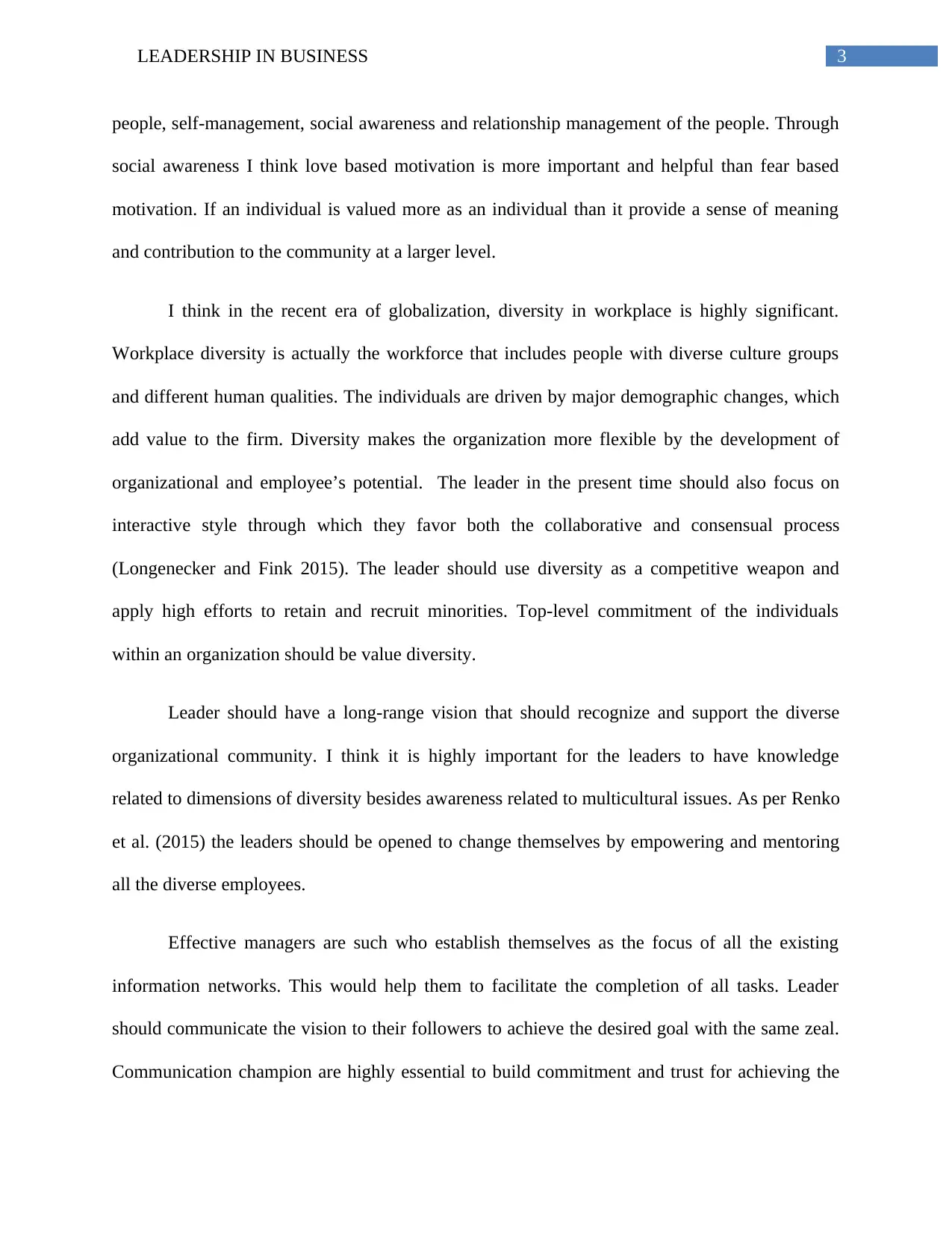
3LEADERSHIP IN BUSINESS
people, self-management, social awareness and relationship management of the people. Through
social awareness I think love based motivation is more important and helpful than fear based
motivation. If an individual is valued more as an individual than it provide a sense of meaning
and contribution to the community at a larger level.
I think in the recent era of globalization, diversity in workplace is highly significant.
Workplace diversity is actually the workforce that includes people with diverse culture groups
and different human qualities. The individuals are driven by major demographic changes, which
add value to the firm. Diversity makes the organization more flexible by the development of
organizational and employee’s potential. The leader in the present time should also focus on
interactive style through which they favor both the collaborative and consensual process
(Longenecker and Fink 2015). The leader should use diversity as a competitive weapon and
apply high efforts to retain and recruit minorities. Top-level commitment of the individuals
within an organization should be value diversity.
Leader should have a long-range vision that should recognize and support the diverse
organizational community. I think it is highly important for the leaders to have knowledge
related to dimensions of diversity besides awareness related to multicultural issues. As per Renko
et al. (2015) the leaders should be opened to change themselves by empowering and mentoring
all the diverse employees.
Effective managers are such who establish themselves as the focus of all the existing
information networks. This would help them to facilitate the completion of all tasks. Leader
should communicate the vision to their followers to achieve the desired goal with the same zeal.
Communication champion are highly essential to build commitment and trust for achieving the
people, self-management, social awareness and relationship management of the people. Through
social awareness I think love based motivation is more important and helpful than fear based
motivation. If an individual is valued more as an individual than it provide a sense of meaning
and contribution to the community at a larger level.
I think in the recent era of globalization, diversity in workplace is highly significant.
Workplace diversity is actually the workforce that includes people with diverse culture groups
and different human qualities. The individuals are driven by major demographic changes, which
add value to the firm. Diversity makes the organization more flexible by the development of
organizational and employee’s potential. The leader in the present time should also focus on
interactive style through which they favor both the collaborative and consensual process
(Longenecker and Fink 2015). The leader should use diversity as a competitive weapon and
apply high efforts to retain and recruit minorities. Top-level commitment of the individuals
within an organization should be value diversity.
Leader should have a long-range vision that should recognize and support the diverse
organizational community. I think it is highly important for the leaders to have knowledge
related to dimensions of diversity besides awareness related to multicultural issues. As per Renko
et al. (2015) the leaders should be opened to change themselves by empowering and mentoring
all the diverse employees.
Effective managers are such who establish themselves as the focus of all the existing
information networks. This would help them to facilitate the completion of all tasks. Leader
should communicate the vision to their followers to achieve the desired goal with the same zeal.
Communication champion are highly essential to build commitment and trust for achieving the
Paraphrase This Document
Need a fresh take? Get an instant paraphrase of this document with our AI Paraphraser
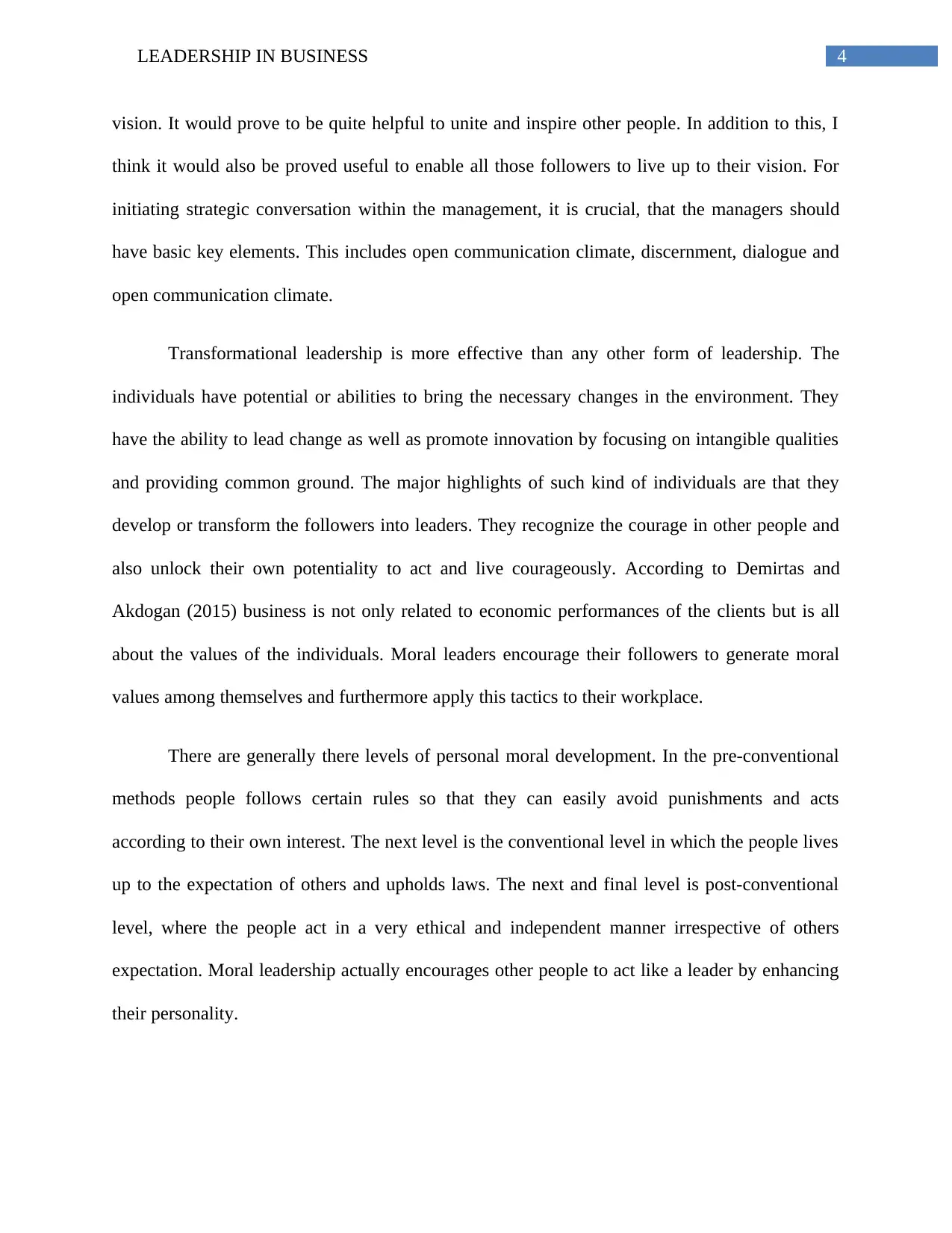
4LEADERSHIP IN BUSINESS
vision. It would prove to be quite helpful to unite and inspire other people. In addition to this, I
think it would also be proved useful to enable all those followers to live up to their vision. For
initiating strategic conversation within the management, it is crucial, that the managers should
have basic key elements. This includes open communication climate, discernment, dialogue and
open communication climate.
Transformational leadership is more effective than any other form of leadership. The
individuals have potential or abilities to bring the necessary changes in the environment. They
have the ability to lead change as well as promote innovation by focusing on intangible qualities
and providing common ground. The major highlights of such kind of individuals are that they
develop or transform the followers into leaders. They recognize the courage in other people and
also unlock their own potentiality to act and live courageously. According to Demirtas and
Akdogan (2015) business is not only related to economic performances of the clients but is all
about the values of the individuals. Moral leaders encourage their followers to generate moral
values among themselves and furthermore apply this tactics to their workplace.
There are generally there levels of personal moral development. In the pre-conventional
methods people follows certain rules so that they can easily avoid punishments and acts
according to their own interest. The next level is the conventional level in which the people lives
up to the expectation of others and upholds laws. The next and final level is post-conventional
level, where the people act in a very ethical and independent manner irrespective of others
expectation. Moral leadership actually encourages other people to act like a leader by enhancing
their personality.
vision. It would prove to be quite helpful to unite and inspire other people. In addition to this, I
think it would also be proved useful to enable all those followers to live up to their vision. For
initiating strategic conversation within the management, it is crucial, that the managers should
have basic key elements. This includes open communication climate, discernment, dialogue and
open communication climate.
Transformational leadership is more effective than any other form of leadership. The
individuals have potential or abilities to bring the necessary changes in the environment. They
have the ability to lead change as well as promote innovation by focusing on intangible qualities
and providing common ground. The major highlights of such kind of individuals are that they
develop or transform the followers into leaders. They recognize the courage in other people and
also unlock their own potentiality to act and live courageously. According to Demirtas and
Akdogan (2015) business is not only related to economic performances of the clients but is all
about the values of the individuals. Moral leaders encourage their followers to generate moral
values among themselves and furthermore apply this tactics to their workplace.
There are generally there levels of personal moral development. In the pre-conventional
methods people follows certain rules so that they can easily avoid punishments and acts
according to their own interest. The next level is the conventional level in which the people lives
up to the expectation of others and upholds laws. The next and final level is post-conventional
level, where the people act in a very ethical and independent manner irrespective of others
expectation. Moral leadership actually encourages other people to act like a leader by enhancing
their personality.
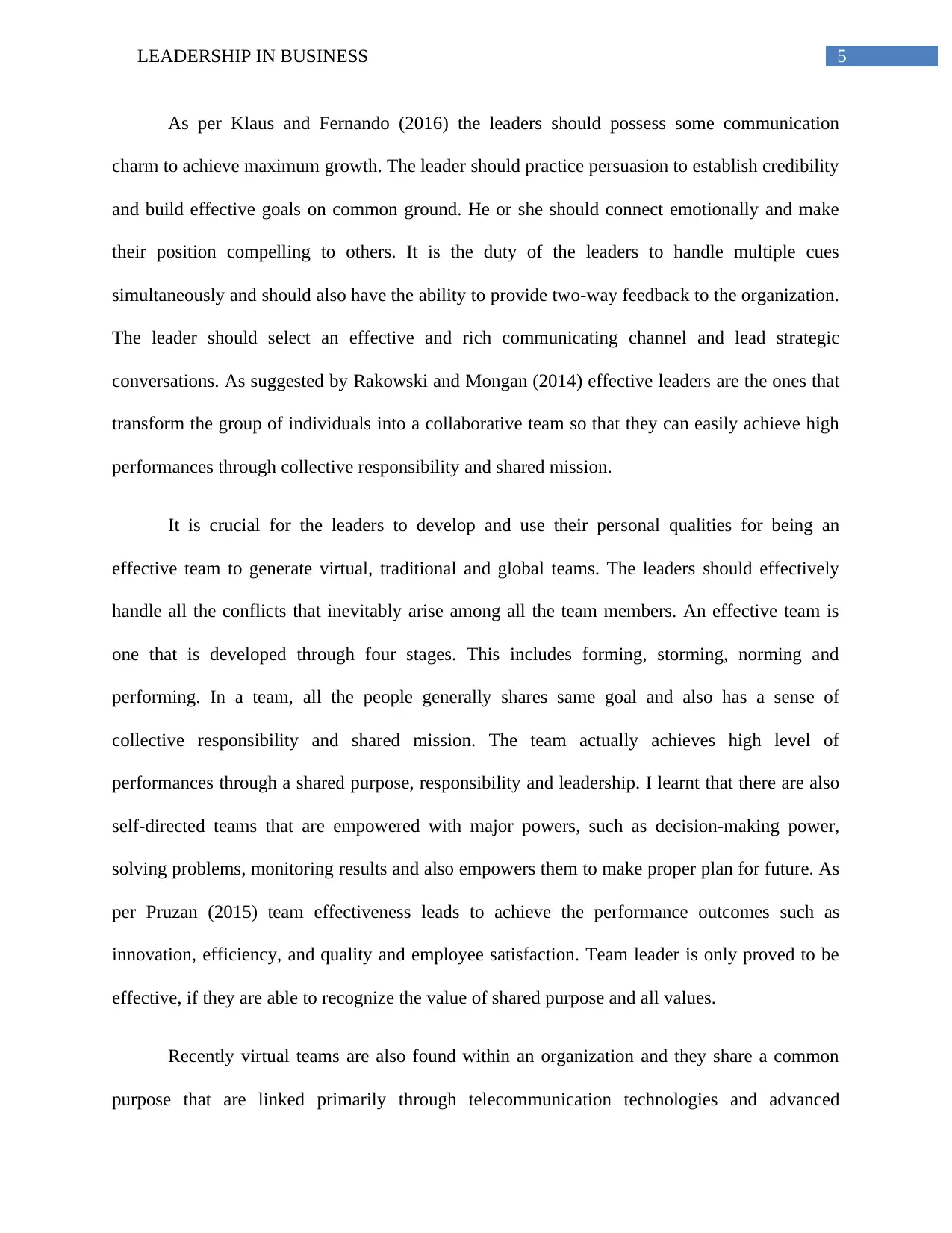
5LEADERSHIP IN BUSINESS
As per Klaus and Fernando (2016) the leaders should possess some communication
charm to achieve maximum growth. The leader should practice persuasion to establish credibility
and build effective goals on common ground. He or she should connect emotionally and make
their position compelling to others. It is the duty of the leaders to handle multiple cues
simultaneously and should also have the ability to provide two-way feedback to the organization.
The leader should select an effective and rich communicating channel and lead strategic
conversations. As suggested by Rakowski and Mongan (2014) effective leaders are the ones that
transform the group of individuals into a collaborative team so that they can easily achieve high
performances through collective responsibility and shared mission.
It is crucial for the leaders to develop and use their personal qualities for being an
effective team to generate virtual, traditional and global teams. The leaders should effectively
handle all the conflicts that inevitably arise among all the team members. An effective team is
one that is developed through four stages. This includes forming, storming, norming and
performing. In a team, all the people generally shares same goal and also has a sense of
collective responsibility and shared mission. The team actually achieves high level of
performances through a shared purpose, responsibility and leadership. I learnt that there are also
self-directed teams that are empowered with major powers, such as decision-making power,
solving problems, monitoring results and also empowers them to make proper plan for future. As
per Pruzan (2015) team effectiveness leads to achieve the performance outcomes such as
innovation, efficiency, and quality and employee satisfaction. Team leader is only proved to be
effective, if they are able to recognize the value of shared purpose and all values.
Recently virtual teams are also found within an organization and they share a common
purpose that are linked primarily through telecommunication technologies and advanced
As per Klaus and Fernando (2016) the leaders should possess some communication
charm to achieve maximum growth. The leader should practice persuasion to establish credibility
and build effective goals on common ground. He or she should connect emotionally and make
their position compelling to others. It is the duty of the leaders to handle multiple cues
simultaneously and should also have the ability to provide two-way feedback to the organization.
The leader should select an effective and rich communicating channel and lead strategic
conversations. As suggested by Rakowski and Mongan (2014) effective leaders are the ones that
transform the group of individuals into a collaborative team so that they can easily achieve high
performances through collective responsibility and shared mission.
It is crucial for the leaders to develop and use their personal qualities for being an
effective team to generate virtual, traditional and global teams. The leaders should effectively
handle all the conflicts that inevitably arise among all the team members. An effective team is
one that is developed through four stages. This includes forming, storming, norming and
performing. In a team, all the people generally shares same goal and also has a sense of
collective responsibility and shared mission. The team actually achieves high level of
performances through a shared purpose, responsibility and leadership. I learnt that there are also
self-directed teams that are empowered with major powers, such as decision-making power,
solving problems, monitoring results and also empowers them to make proper plan for future. As
per Pruzan (2015) team effectiveness leads to achieve the performance outcomes such as
innovation, efficiency, and quality and employee satisfaction. Team leader is only proved to be
effective, if they are able to recognize the value of shared purpose and all values.
Recently virtual teams are also found within an organization and they share a common
purpose that are linked primarily through telecommunication technologies and advanced
⊘ This is a preview!⊘
Do you want full access?
Subscribe today to unlock all pages.

Trusted by 1+ million students worldwide
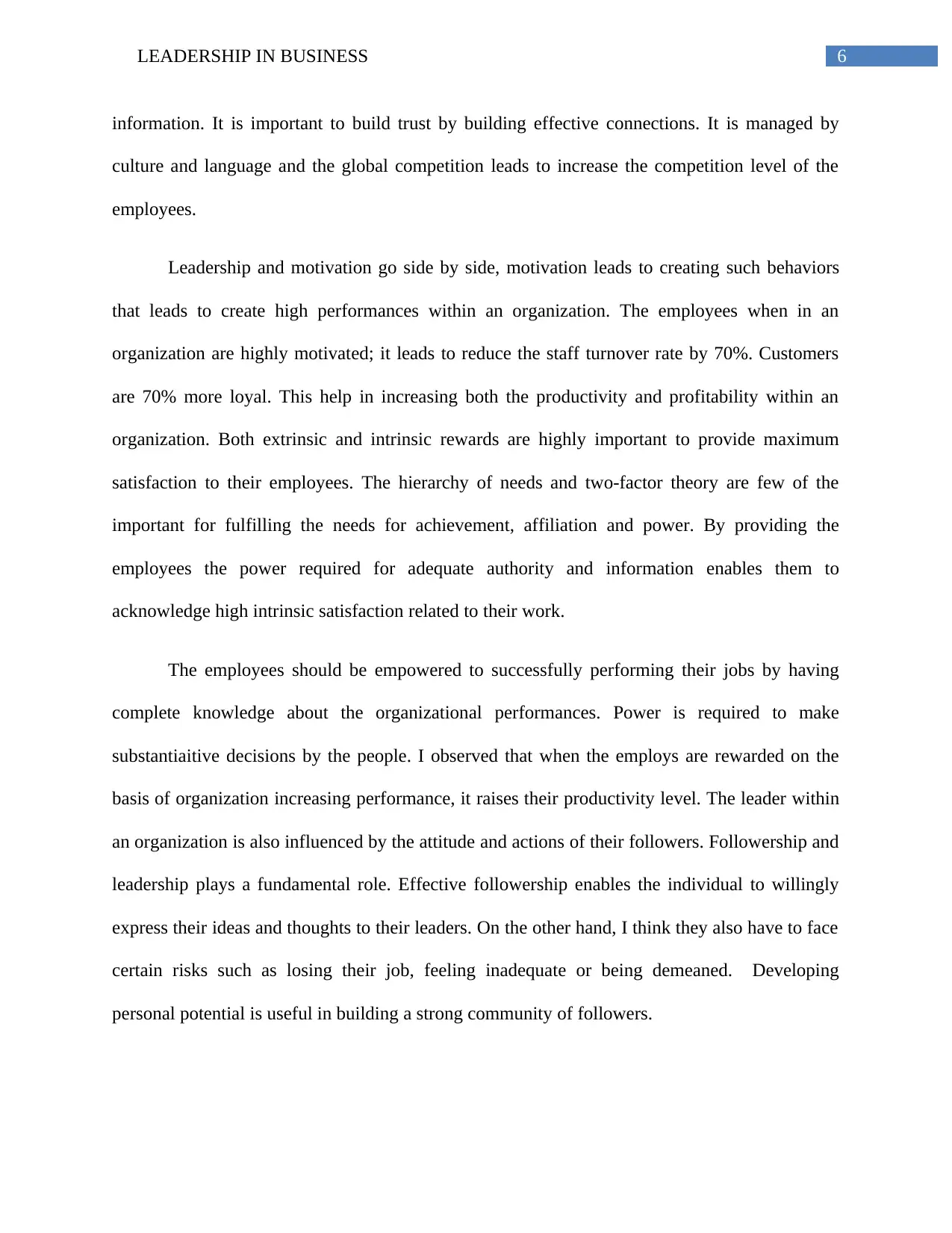
6LEADERSHIP IN BUSINESS
information. It is important to build trust by building effective connections. It is managed by
culture and language and the global competition leads to increase the competition level of the
employees.
Leadership and motivation go side by side, motivation leads to creating such behaviors
that leads to create high performances within an organization. The employees when in an
organization are highly motivated; it leads to reduce the staff turnover rate by 70%. Customers
are 70% more loyal. This help in increasing both the productivity and profitability within an
organization. Both extrinsic and intrinsic rewards are highly important to provide maximum
satisfaction to their employees. The hierarchy of needs and two-factor theory are few of the
important for fulfilling the needs for achievement, affiliation and power. By providing the
employees the power required for adequate authority and information enables them to
acknowledge high intrinsic satisfaction related to their work.
The employees should be empowered to successfully performing their jobs by having
complete knowledge about the organizational performances. Power is required to make
substantiaitive decisions by the people. I observed that when the employs are rewarded on the
basis of organization increasing performance, it raises their productivity level. The leader within
an organization is also influenced by the attitude and actions of their followers. Followership and
leadership plays a fundamental role. Effective followership enables the individual to willingly
express their ideas and thoughts to their leaders. On the other hand, I think they also have to face
certain risks such as losing their job, feeling inadequate or being demeaned. Developing
personal potential is useful in building a strong community of followers.
information. It is important to build trust by building effective connections. It is managed by
culture and language and the global competition leads to increase the competition level of the
employees.
Leadership and motivation go side by side, motivation leads to creating such behaviors
that leads to create high performances within an organization. The employees when in an
organization are highly motivated; it leads to reduce the staff turnover rate by 70%. Customers
are 70% more loyal. This help in increasing both the productivity and profitability within an
organization. Both extrinsic and intrinsic rewards are highly important to provide maximum
satisfaction to their employees. The hierarchy of needs and two-factor theory are few of the
important for fulfilling the needs for achievement, affiliation and power. By providing the
employees the power required for adequate authority and information enables them to
acknowledge high intrinsic satisfaction related to their work.
The employees should be empowered to successfully performing their jobs by having
complete knowledge about the organizational performances. Power is required to make
substantiaitive decisions by the people. I observed that when the employs are rewarded on the
basis of organization increasing performance, it raises their productivity level. The leader within
an organization is also influenced by the attitude and actions of their followers. Followership and
leadership plays a fundamental role. Effective followership enables the individual to willingly
express their ideas and thoughts to their leaders. On the other hand, I think they also have to face
certain risks such as losing their job, feeling inadequate or being demeaned. Developing
personal potential is useful in building a strong community of followers.
Paraphrase This Document
Need a fresh take? Get an instant paraphrase of this document with our AI Paraphraser
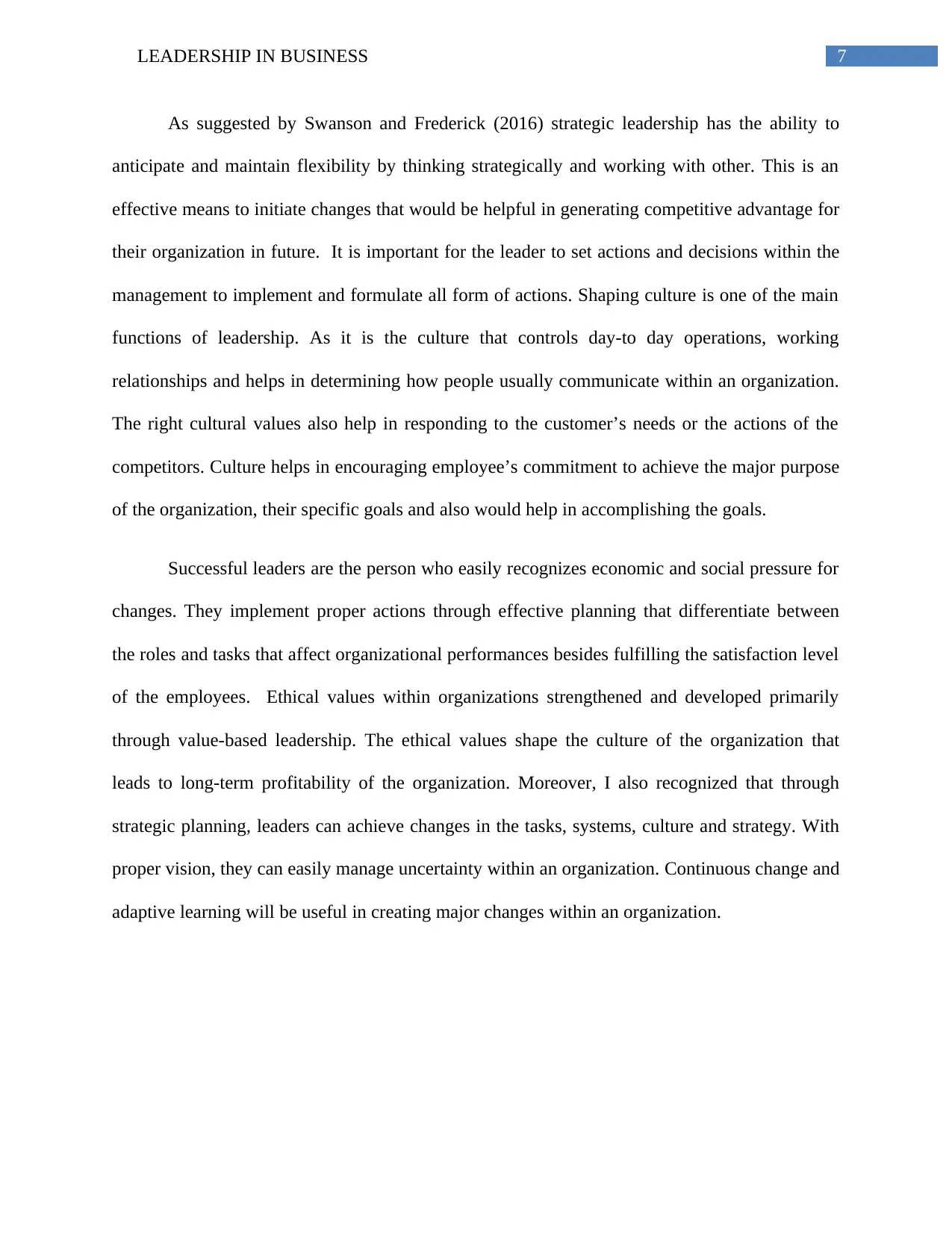
7LEADERSHIP IN BUSINESS
As suggested by Swanson and Frederick (2016) strategic leadership has the ability to
anticipate and maintain flexibility by thinking strategically and working with other. This is an
effective means to initiate changes that would be helpful in generating competitive advantage for
their organization in future. It is important for the leader to set actions and decisions within the
management to implement and formulate all form of actions. Shaping culture is one of the main
functions of leadership. As it is the culture that controls day-to day operations, working
relationships and helps in determining how people usually communicate within an organization.
The right cultural values also help in responding to the customer’s needs or the actions of the
competitors. Culture helps in encouraging employee’s commitment to achieve the major purpose
of the organization, their specific goals and also would help in accomplishing the goals.
Successful leaders are the person who easily recognizes economic and social pressure for
changes. They implement proper actions through effective planning that differentiate between
the roles and tasks that affect organizational performances besides fulfilling the satisfaction level
of the employees. Ethical values within organizations strengthened and developed primarily
through value-based leadership. The ethical values shape the culture of the organization that
leads to long-term profitability of the organization. Moreover, I also recognized that through
strategic planning, leaders can achieve changes in the tasks, systems, culture and strategy. With
proper vision, they can easily manage uncertainty within an organization. Continuous change and
adaptive learning will be useful in creating major changes within an organization.
As suggested by Swanson and Frederick (2016) strategic leadership has the ability to
anticipate and maintain flexibility by thinking strategically and working with other. This is an
effective means to initiate changes that would be helpful in generating competitive advantage for
their organization in future. It is important for the leader to set actions and decisions within the
management to implement and formulate all form of actions. Shaping culture is one of the main
functions of leadership. As it is the culture that controls day-to day operations, working
relationships and helps in determining how people usually communicate within an organization.
The right cultural values also help in responding to the customer’s needs or the actions of the
competitors. Culture helps in encouraging employee’s commitment to achieve the major purpose
of the organization, their specific goals and also would help in accomplishing the goals.
Successful leaders are the person who easily recognizes economic and social pressure for
changes. They implement proper actions through effective planning that differentiate between
the roles and tasks that affect organizational performances besides fulfilling the satisfaction level
of the employees. Ethical values within organizations strengthened and developed primarily
through value-based leadership. The ethical values shape the culture of the organization that
leads to long-term profitability of the organization. Moreover, I also recognized that through
strategic planning, leaders can achieve changes in the tasks, systems, culture and strategy. With
proper vision, they can easily manage uncertainty within an organization. Continuous change and
adaptive learning will be useful in creating major changes within an organization.
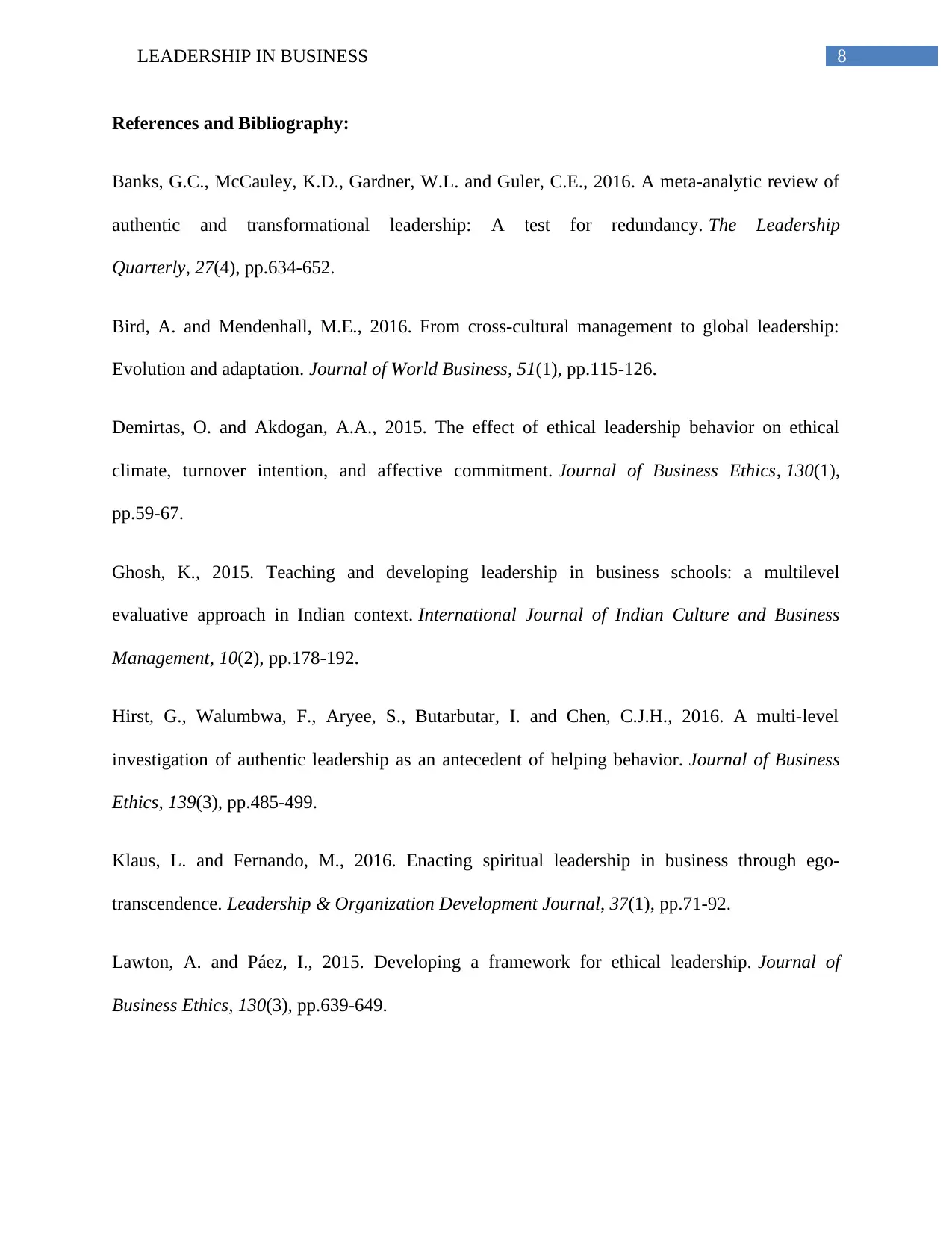
8LEADERSHIP IN BUSINESS
References and Bibliography:
Banks, G.C., McCauley, K.D., Gardner, W.L. and Guler, C.E., 2016. A meta-analytic review of
authentic and transformational leadership: A test for redundancy. The Leadership
Quarterly, 27(4), pp.634-652.
Bird, A. and Mendenhall, M.E., 2016. From cross-cultural management to global leadership:
Evolution and adaptation. Journal of World Business, 51(1), pp.115-126.
Demirtas, O. and Akdogan, A.A., 2015. The effect of ethical leadership behavior on ethical
climate, turnover intention, and affective commitment. Journal of Business Ethics, 130(1),
pp.59-67.
Ghosh, K., 2015. Teaching and developing leadership in business schools: a multilevel
evaluative approach in Indian context. International Journal of Indian Culture and Business
Management, 10(2), pp.178-192.
Hirst, G., Walumbwa, F., Aryee, S., Butarbutar, I. and Chen, C.J.H., 2016. A multi-level
investigation of authentic leadership as an antecedent of helping behavior. Journal of Business
Ethics, 139(3), pp.485-499.
Klaus, L. and Fernando, M., 2016. Enacting spiritual leadership in business through ego-
transcendence. Leadership & Organization Development Journal, 37(1), pp.71-92.
Lawton, A. and Páez, I., 2015. Developing a framework for ethical leadership. Journal of
Business Ethics, 130(3), pp.639-649.
References and Bibliography:
Banks, G.C., McCauley, K.D., Gardner, W.L. and Guler, C.E., 2016. A meta-analytic review of
authentic and transformational leadership: A test for redundancy. The Leadership
Quarterly, 27(4), pp.634-652.
Bird, A. and Mendenhall, M.E., 2016. From cross-cultural management to global leadership:
Evolution and adaptation. Journal of World Business, 51(1), pp.115-126.
Demirtas, O. and Akdogan, A.A., 2015. The effect of ethical leadership behavior on ethical
climate, turnover intention, and affective commitment. Journal of Business Ethics, 130(1),
pp.59-67.
Ghosh, K., 2015. Teaching and developing leadership in business schools: a multilevel
evaluative approach in Indian context. International Journal of Indian Culture and Business
Management, 10(2), pp.178-192.
Hirst, G., Walumbwa, F., Aryee, S., Butarbutar, I. and Chen, C.J.H., 2016. A multi-level
investigation of authentic leadership as an antecedent of helping behavior. Journal of Business
Ethics, 139(3), pp.485-499.
Klaus, L. and Fernando, M., 2016. Enacting spiritual leadership in business through ego-
transcendence. Leadership & Organization Development Journal, 37(1), pp.71-92.
Lawton, A. and Páez, I., 2015. Developing a framework for ethical leadership. Journal of
Business Ethics, 130(3), pp.639-649.
⊘ This is a preview!⊘
Do you want full access?
Subscribe today to unlock all pages.

Trusted by 1+ million students worldwide
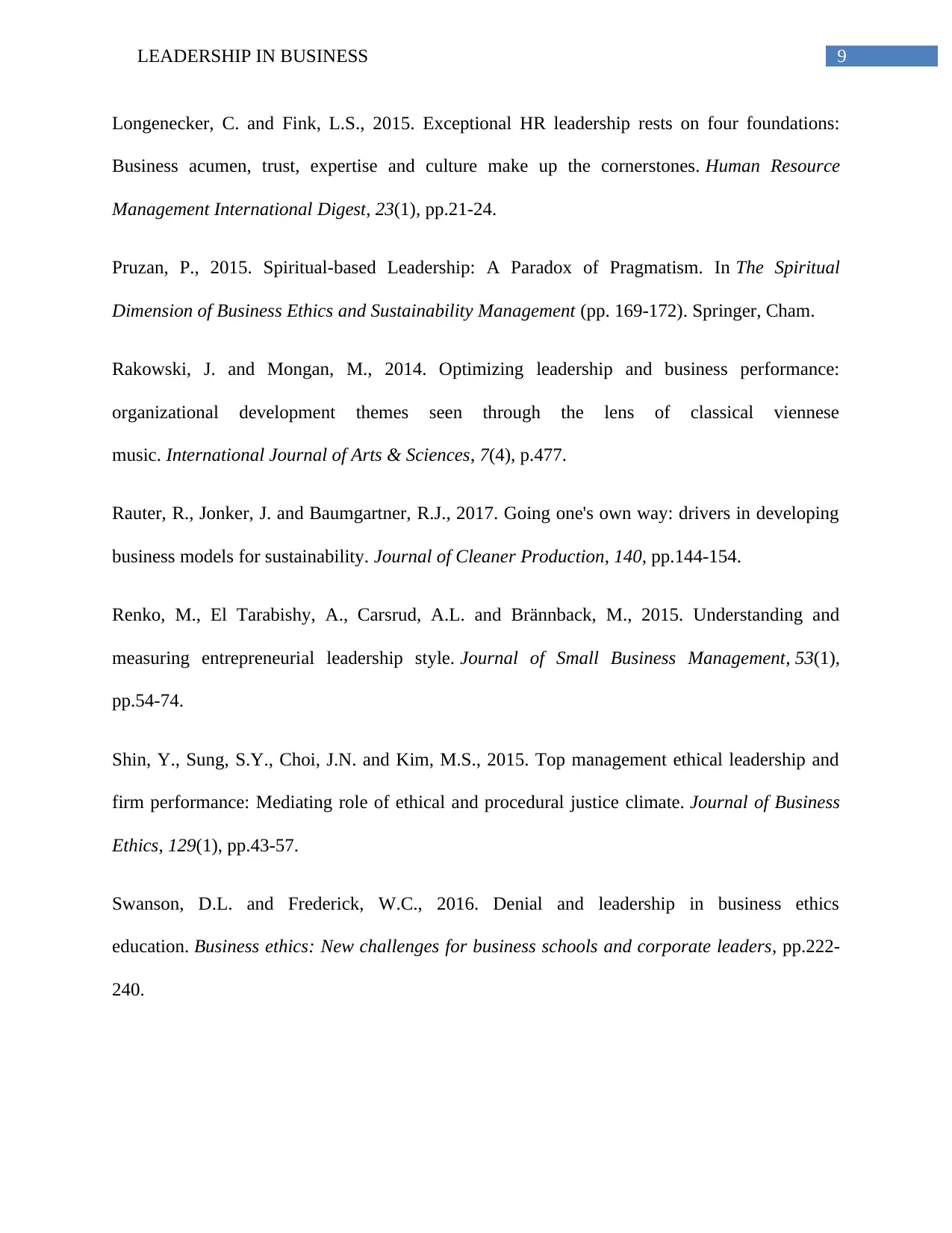
9LEADERSHIP IN BUSINESS
Longenecker, C. and Fink, L.S., 2015. Exceptional HR leadership rests on four foundations:
Business acumen, trust, expertise and culture make up the cornerstones. Human Resource
Management International Digest, 23(1), pp.21-24.
Pruzan, P., 2015. Spiritual-based Leadership: A Paradox of Pragmatism. In The Spiritual
Dimension of Business Ethics and Sustainability Management (pp. 169-172). Springer, Cham.
Rakowski, J. and Mongan, M., 2014. Optimizing leadership and business performance:
organizational development themes seen through the lens of classical viennese
music. International Journal of Arts & Sciences, 7(4), p.477.
Rauter, R., Jonker, J. and Baumgartner, R.J., 2017. Going one's own way: drivers in developing
business models for sustainability. Journal of Cleaner Production, 140, pp.144-154.
Renko, M., El Tarabishy, A., Carsrud, A.L. and Brännback, M., 2015. Understanding and
measuring entrepreneurial leadership style. Journal of Small Business Management, 53(1),
pp.54-74.
Shin, Y., Sung, S.Y., Choi, J.N. and Kim, M.S., 2015. Top management ethical leadership and
firm performance: Mediating role of ethical and procedural justice climate. Journal of Business
Ethics, 129(1), pp.43-57.
Swanson, D.L. and Frederick, W.C., 2016. Denial and leadership in business ethics
education. Business ethics: New challenges for business schools and corporate leaders, pp.222-
240.
Longenecker, C. and Fink, L.S., 2015. Exceptional HR leadership rests on four foundations:
Business acumen, trust, expertise and culture make up the cornerstones. Human Resource
Management International Digest, 23(1), pp.21-24.
Pruzan, P., 2015. Spiritual-based Leadership: A Paradox of Pragmatism. In The Spiritual
Dimension of Business Ethics and Sustainability Management (pp. 169-172). Springer, Cham.
Rakowski, J. and Mongan, M., 2014. Optimizing leadership and business performance:
organizational development themes seen through the lens of classical viennese
music. International Journal of Arts & Sciences, 7(4), p.477.
Rauter, R., Jonker, J. and Baumgartner, R.J., 2017. Going one's own way: drivers in developing
business models for sustainability. Journal of Cleaner Production, 140, pp.144-154.
Renko, M., El Tarabishy, A., Carsrud, A.L. and Brännback, M., 2015. Understanding and
measuring entrepreneurial leadership style. Journal of Small Business Management, 53(1),
pp.54-74.
Shin, Y., Sung, S.Y., Choi, J.N. and Kim, M.S., 2015. Top management ethical leadership and
firm performance: Mediating role of ethical and procedural justice climate. Journal of Business
Ethics, 129(1), pp.43-57.
Swanson, D.L. and Frederick, W.C., 2016. Denial and leadership in business ethics
education. Business ethics: New challenges for business schools and corporate leaders, pp.222-
240.
Paraphrase This Document
Need a fresh take? Get an instant paraphrase of this document with our AI Paraphraser
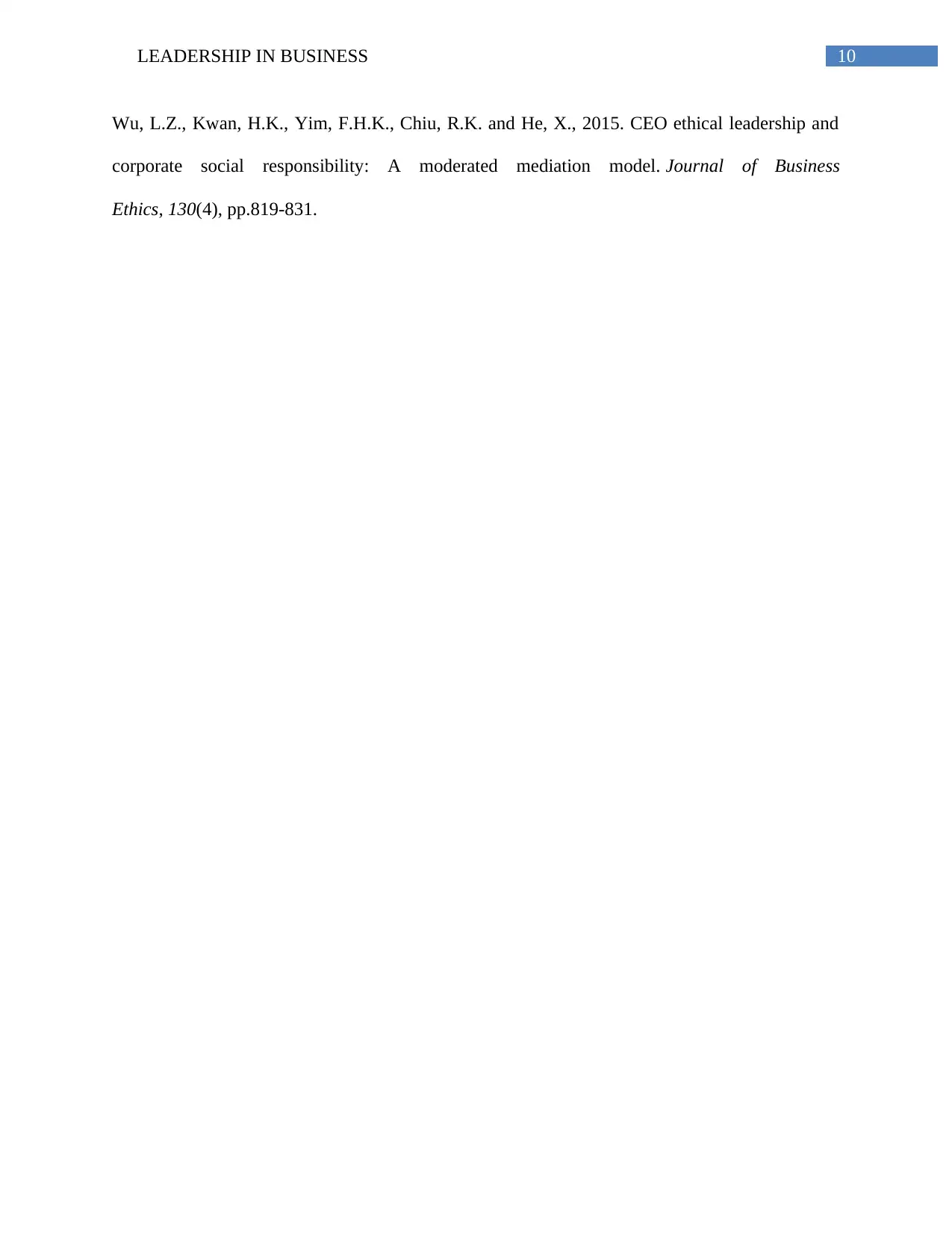
10LEADERSHIP IN BUSINESS
Wu, L.Z., Kwan, H.K., Yim, F.H.K., Chiu, R.K. and He, X., 2015. CEO ethical leadership and
corporate social responsibility: A moderated mediation model. Journal of Business
Ethics, 130(4), pp.819-831.
Wu, L.Z., Kwan, H.K., Yim, F.H.K., Chiu, R.K. and He, X., 2015. CEO ethical leadership and
corporate social responsibility: A moderated mediation model. Journal of Business
Ethics, 130(4), pp.819-831.
1 out of 11
Related Documents
Your All-in-One AI-Powered Toolkit for Academic Success.
+13062052269
info@desklib.com
Available 24*7 on WhatsApp / Email
![[object Object]](/_next/static/media/star-bottom.7253800d.svg)
Unlock your academic potential
Copyright © 2020–2025 A2Z Services. All Rights Reserved. Developed and managed by ZUCOL.



